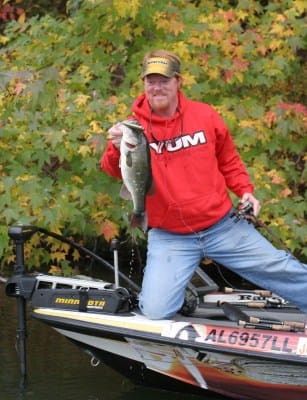
It’s fall and for many bass anglers that means one thing: School’s in. Bass schools, that is. This time of year, roaming packs of largemouths, spots and even smallmouths chase pods of shad to the surface where they attack the baitfish with reckless abandon. On some lakes, entire coves can erupt in a feeding frenzy as bass slash at bait. It’s almost too easy. At least it seems like it should be.
For every “easy” school of breaking bass, there are just as many that can turn a great day into a frustrating one. What seems like a slam-dunk, a sure bet for loading up a livewell or just having a ton of fun can be downright maddening as the fish refuse the most obvious baits.
“When they are schooling, they are so focused on the shad they are chasing, they will often ignore anything that doesn’t exactly match those shad,” says Alabama professional angler and guide Jimmy Mason.
That’s not to say you have to stick a live shad on a hook if you want to catch schoolies. They can be caught on artificials. But Mason says it can be vital to use a lure that not only looks like a shad, but is the same size as the actual baitfish the bass are eating. One of his favorites is an Xcalibur Rattle Bait, a lipless crankbait that closely resembles a shad and comes in a variety of sizes. But even they don’t always work, which is why it’s vital to have an itchy trigger finger.
“If one lure isn’t working, I’ll switch. I won’t spend much time with one bait before I’m switching, either,” says Mason. “Too many anglers throw one bait and then give up if it doesn’t work. Or they keep throwing it, hoping it will eventually work. I’ll go through a whole bunch of baits until I find the right one. Sooner or later, I’ll figure them out.”
His choices are pretty broad, but there’s a good chance he’ll start with a topwater. Why not? If the bass are feeding on top, it only makes sense to throw a surface lure. Besides, what’s more fun that watching a bass bust a Spook or Pop R? Surprisingly, however, even the most realistic topwater lure may not work, either because it’s the wrong size, the wrong color or the wrong something else.
Sometimes, something as simple as switching to a smaller lure can be the ticket to a bent rod. While most anglers are chucking full-sized Zara Spooks, Chug Bugs or some other common topwater, Mason ties on a Heddon Spittin’ Image Junior, or instead of using a full-size soft plastic jerkbait, he’ll drop down to a smaller one. He’s not sure why smaller baits often work better. It could be because the shad the bass are eating are smaller. Again, you don’t necessarily have to use a lure that looks exactly like a shad, but using one that’s about the same size as the real thing can make a huge difference.

In many situations, the “right” bait doesn’t even resemble a shad. Although the bass may be busting bait on the surface, Mason will actually fish under those visible fish if he’s having trouble hooking them on a surface bait. His favorite is a shaky-head rig, usually a finesse worm impaled on a stand-up jig head. Mason also uses a Carolina-rigged worm or lizard.
“I’ll also use it if the fish have stopped busting on the surface. They probably haven’t gone anywhere, but they are laying low and waiting for another school of shad to come by,” he says.
Eventually, they’ll come back up. And when they do, it pays to be ready, because if your not, your day can go from thrilling to chilling. It’s a tough lesson when school’s in.







